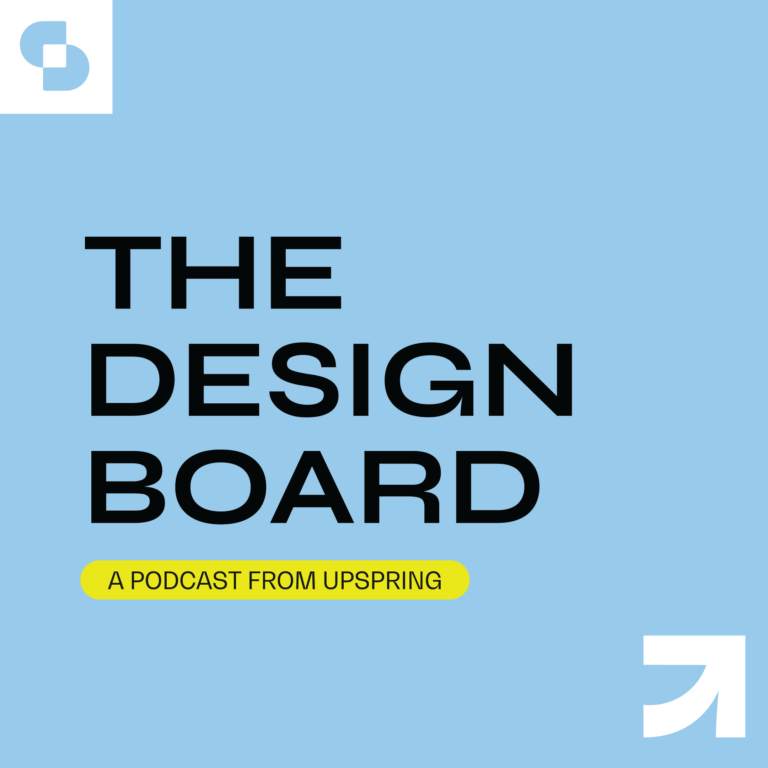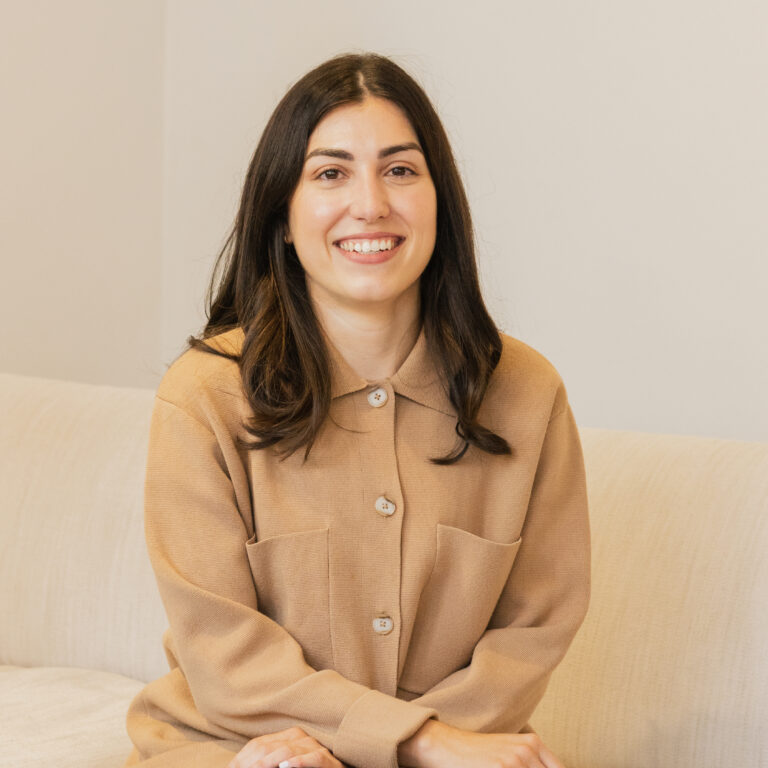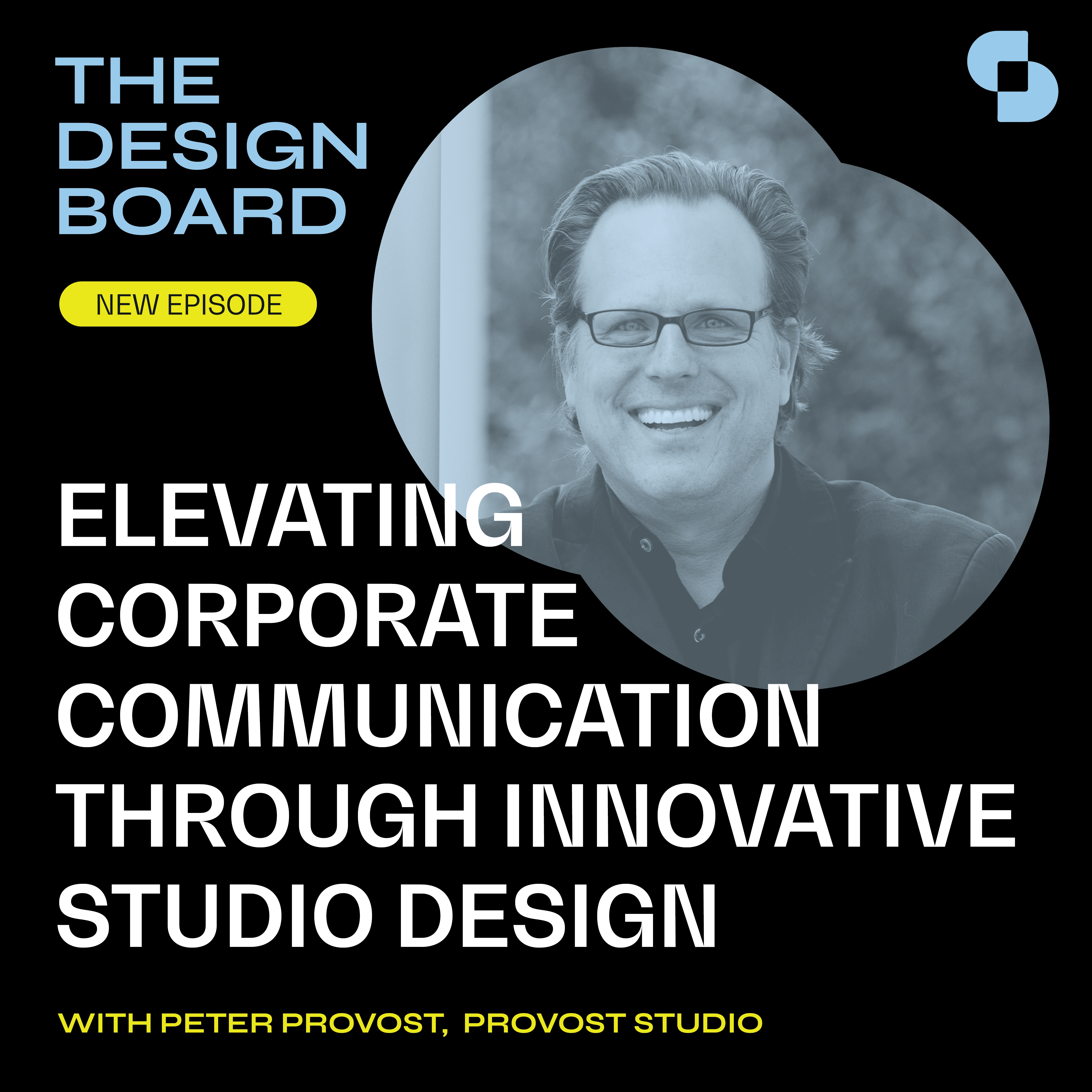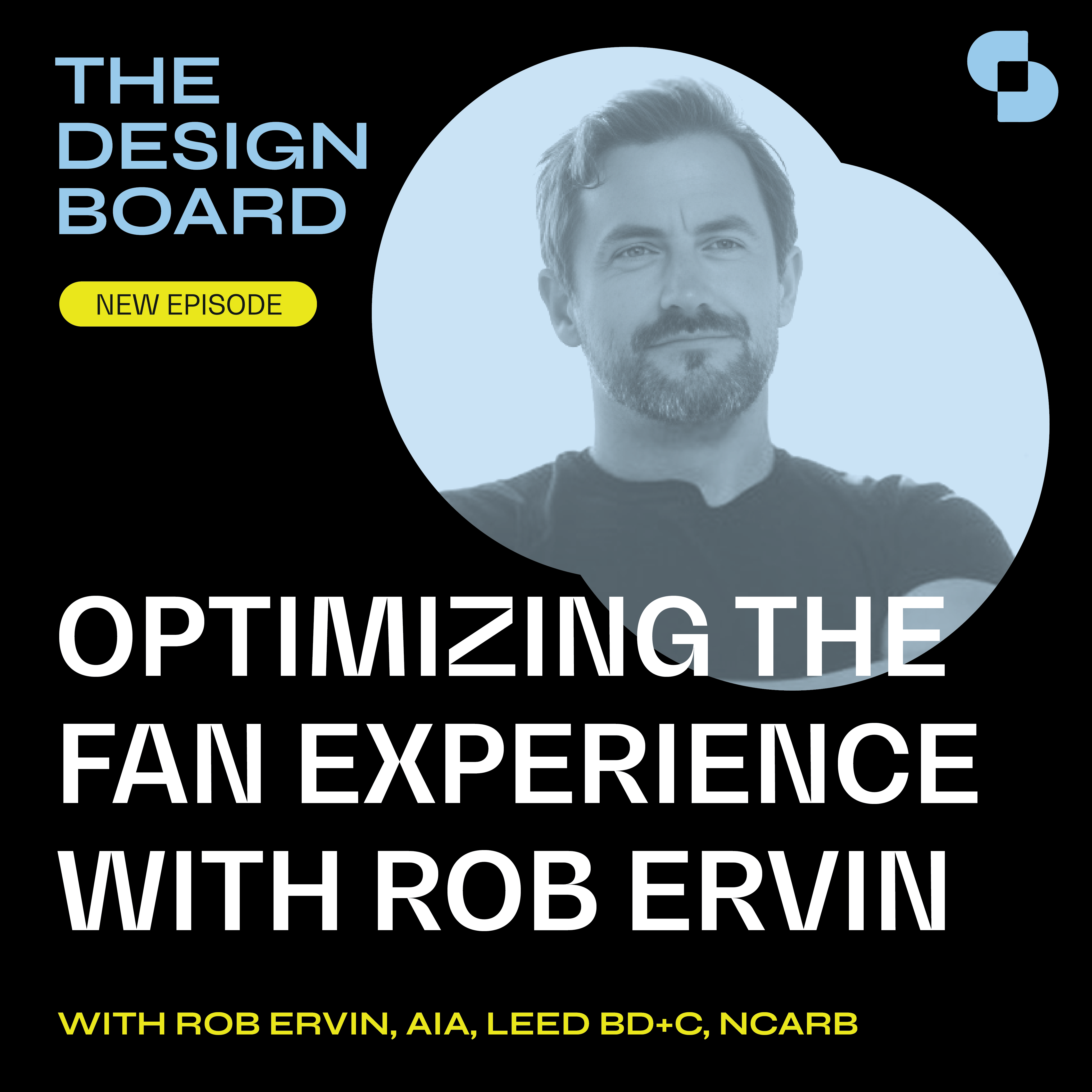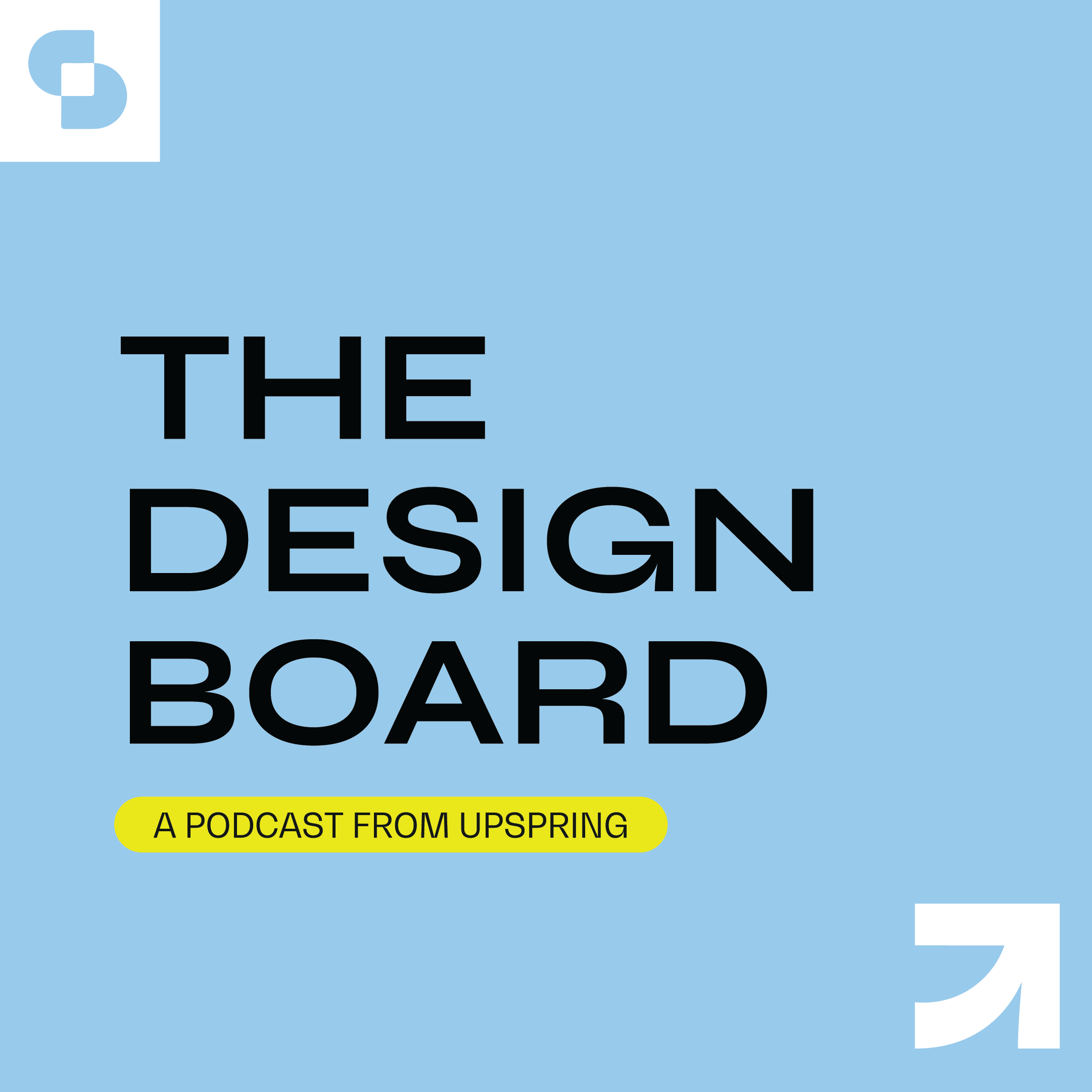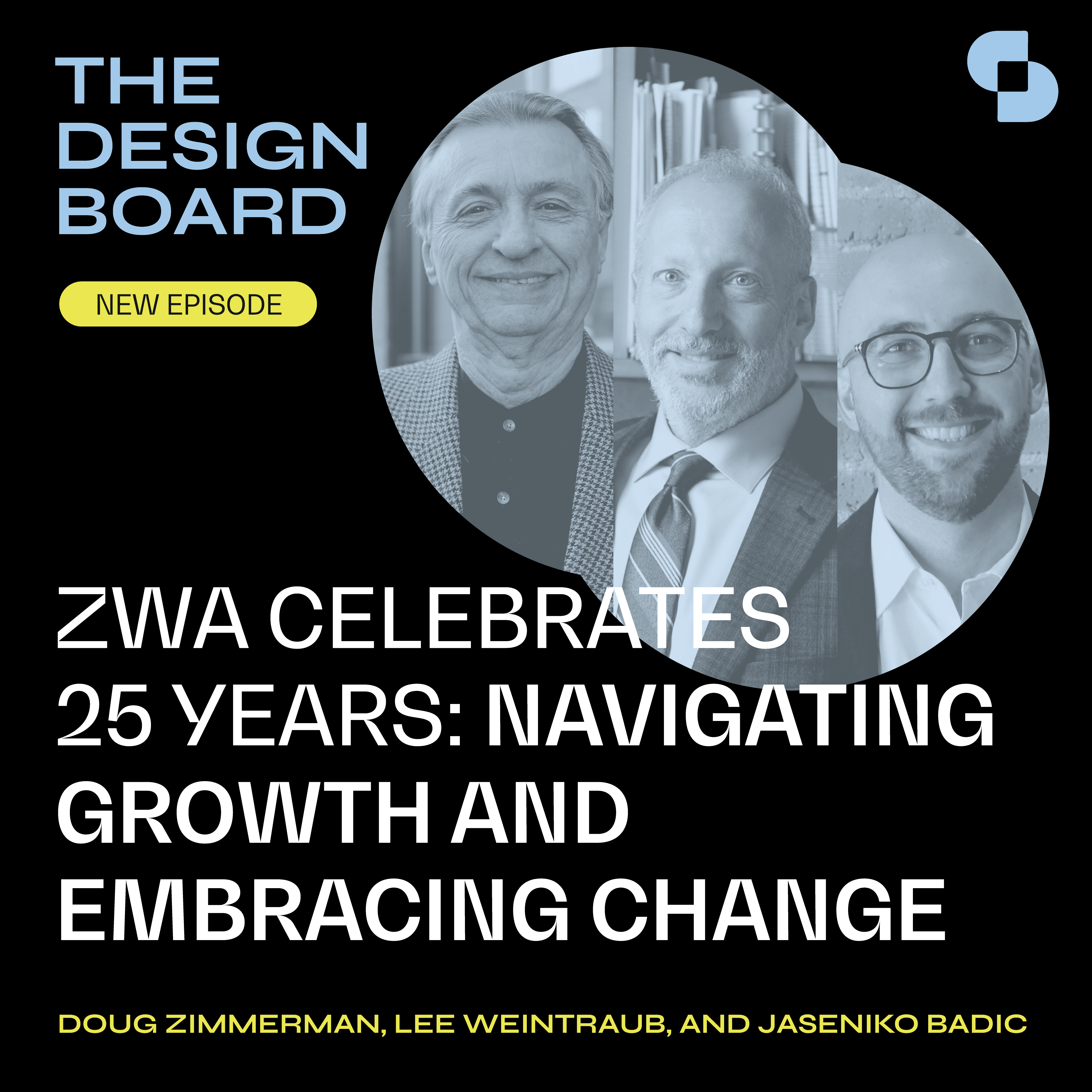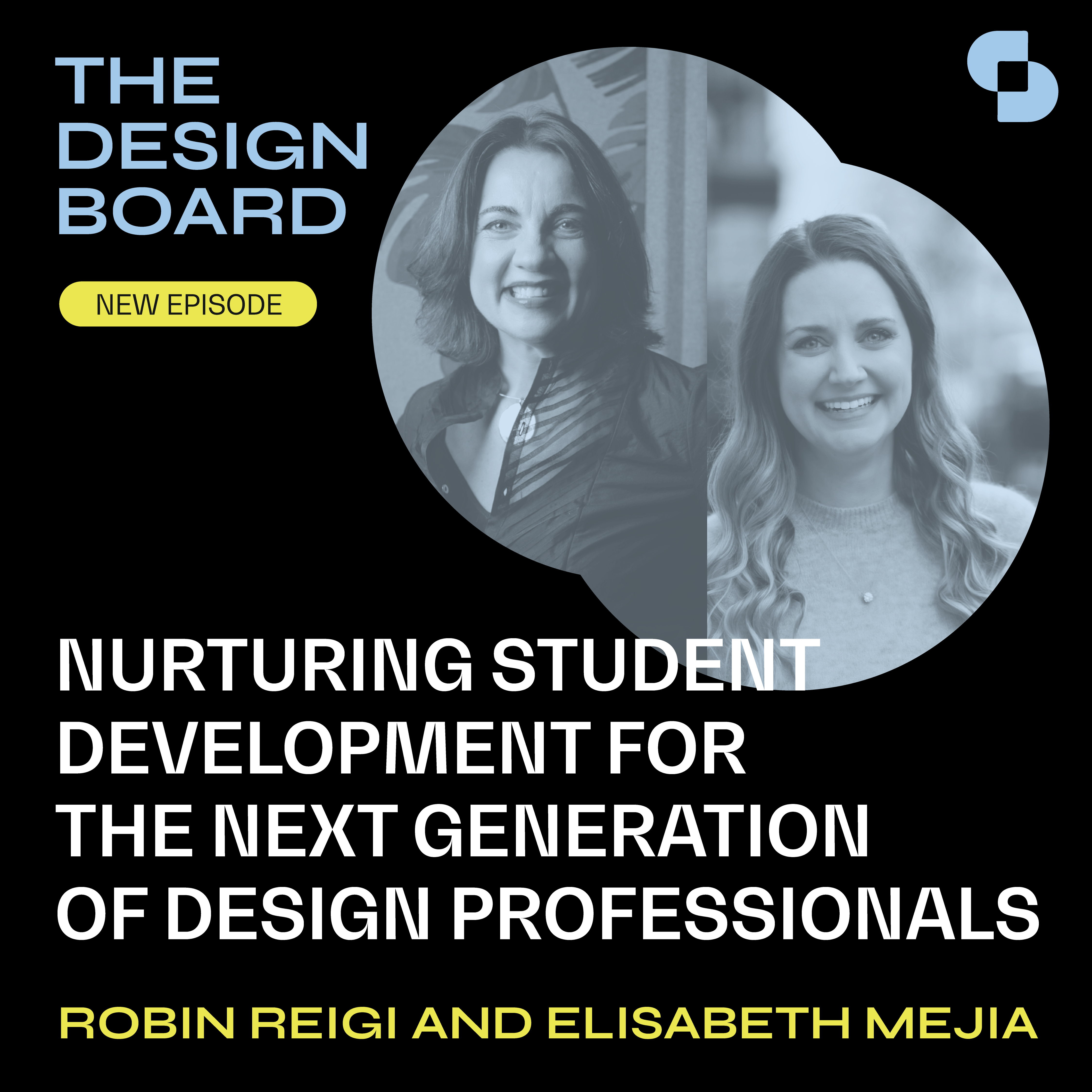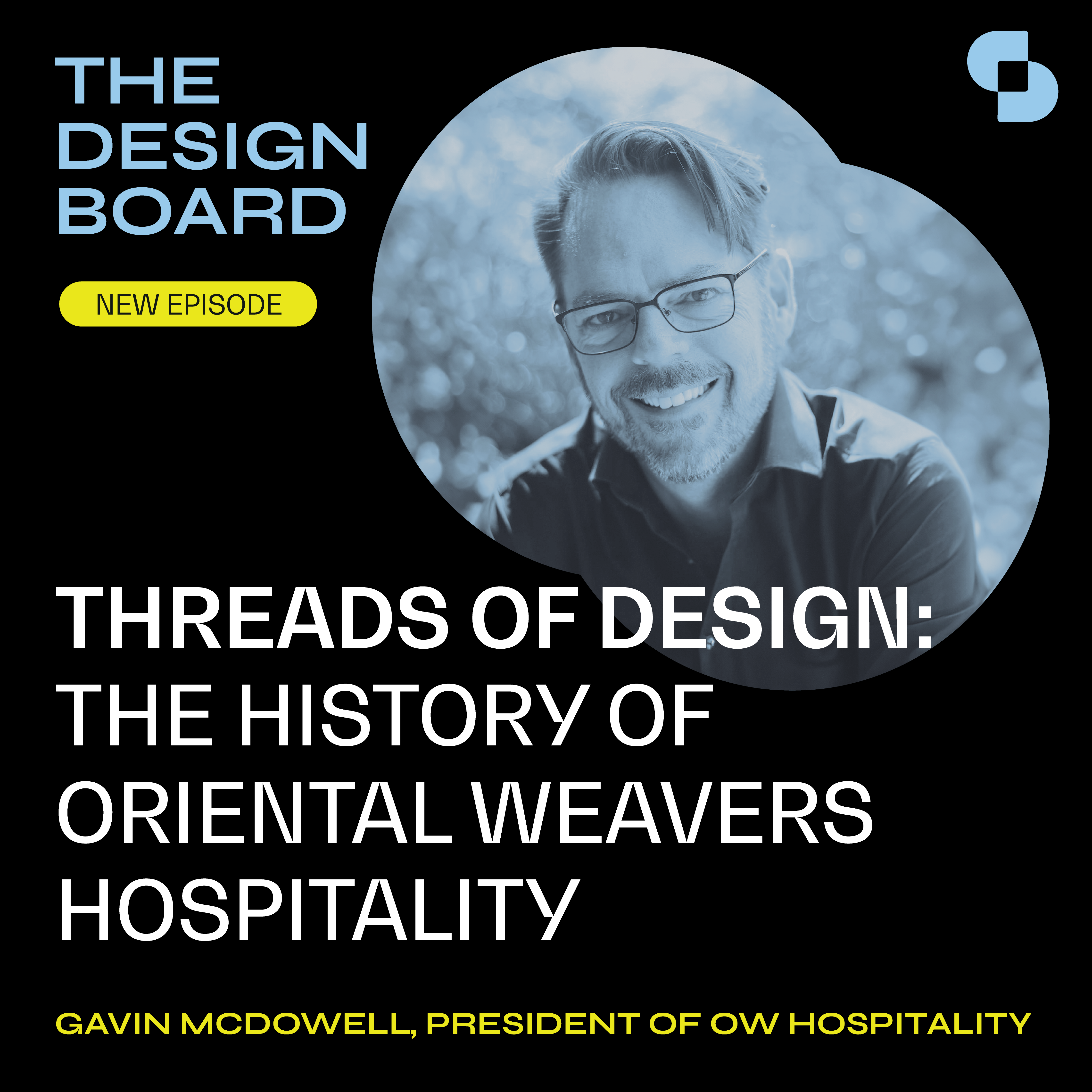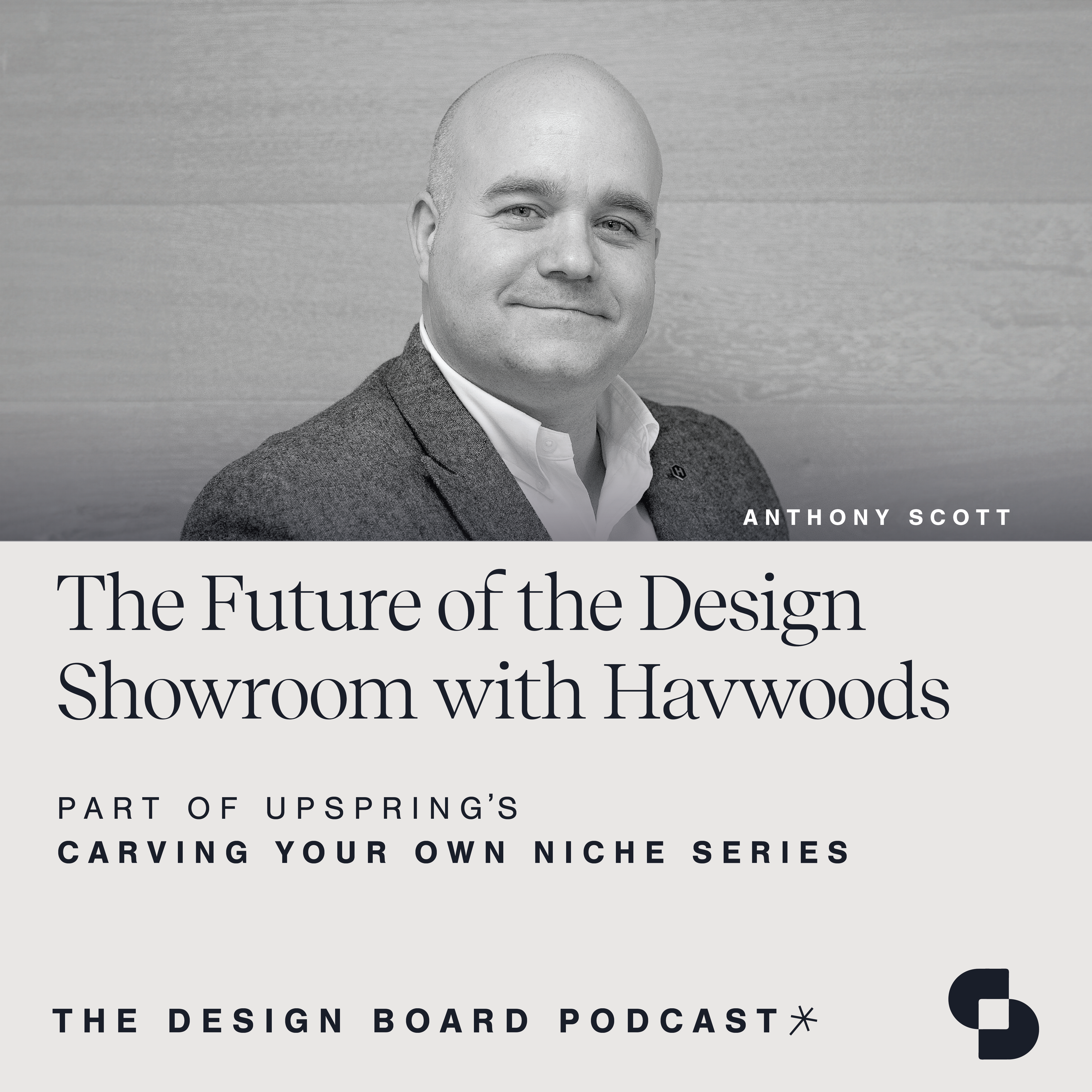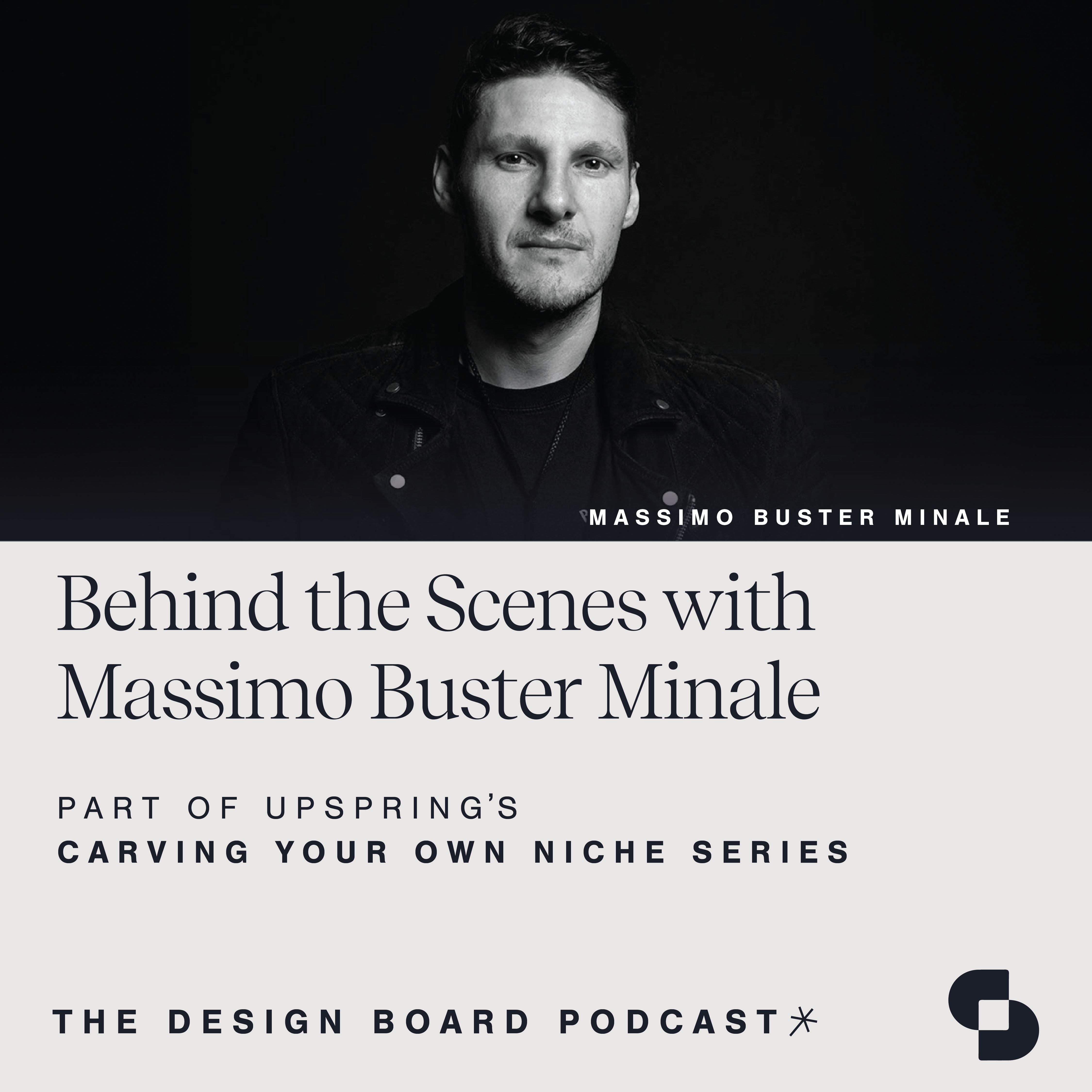Championing sustainability in the architecture and design industry and beyond can help to create a more sustainable future. This episode unpacks the importance of fostering a culture that drives sustainability goals and highlights how we can all become advocates for sustainability. Host Caroline Saba chats with Pablo La Roche, Principal & Sustainable Design Director, CRTKL, Steven South, LEED AP, NCIDQ, IIDA, Fitwel Ambassador, Design Director, Senior Associate Spectorgroup, Ellen Mitchell, Director of Sustainability & Applied Research, LPA Design Studios, and Martha Larson, Director of Sustainability, RMF to share ideas and offer insight on how we can create a more sustainable future for all.
The Design Board, by UpSpring, is a proud member of SANDOW Design Group’s SURROUND Podcast Network, home to the architecture and design industry’s premier shows.
Speaker 1:
Welcome to the Design Board, a podcast created by the team at UpSpring that focuses on design, development and everything in between. We invite innovators in our industry and explore topics that support your growth in every way. The Design Board is a proud member of SURROUND, a podcast network from SANDOW Design Group featuring the architecture and design industry’s premier shows. Check it out at surroundpodcast.com.
Caroline Saba:
Hi everyone, I’m your host, Caroline Saba, Vice President at UpSpring, a PR and Digital Marketing Agency dedicated to the design industry. I’m joined by three incredible industry professionals, and today we are going to be talking about the importance of champion sustainability as we look to create a greener future. But let’s start off with some quick introductions. First, we have Pablo La Roche, a Principal and Sustainable Design Director at CRTKL, where he leads the firm sustainability initiatives and works on projects worldwide. I’m also joined by Steven South, Design Director at Spectorgroup. Steven champions the firm’s mission to create meaningful spaces reflective of design excellence, sustainability, and innovation. Also with us is Ellen Mitchelle, Director of Sustainability and Applied Research at LPA Design Studios. Ellen is a recognized leader in the industry’s move to create more energy efficient, equitable, and resilient built environments.
And lastly, we have Martha Larson as Director of Sustainability at RMF Engineering. Martha leads climate driven and carbon reduction efforts across the firm’s utility planning portfolio. Thank you all for being with me today. I’m so excited about this conversation.
Ellen Mitchelle:
Thank you.
Pablo La Roche:
Thank you.
Steven South:
Thank you.
Martha Larson:
Of course.
Caroline Saba:
So championing sustainability in the architecture and design industry can help create a more sustainable future. What are some steps that a company can take to incorporate sustainability into its core values and mission statement? Ellen, I’d love to start with you on this one.
Ellen Mitchelle:
Sure, thanks. I’m going to start off and be a little bit provocative and say that your mission statement is important, but it’s worthless if it’s not backed up by action. So I’m coming from LPA and we identify ourselves as a very sort of sustainable design firm. And our motto is every project, every budget, every scale. But the reality is pretty meaningless if it’s not actually showing up in the work. So I guess what I would say is that it is important to take the time to find the words, but it’s more important to take the time to actually manifest those words into reality.
Caroline Saba:
That’s really interesting. Thank you for sharing that. Martha, I’d like to hear your insights too here.
Martha Larson:
Yes. What I find is that actually many mission and value statements are already aligned with many of the core principles of sustainability. And I think the key is right upfront, especially in a project planning phase, to find those connections and highlight them. So things on being responsible stewards of our resources, creating healthy environments, tackling global challenges, these are all phrases that you might see in a mission statement. And one of the important framing exercises is to connect those existing mission statement phrases to the sustainability goals and show how it’s all very holistic works together.
Caroline Saba:
I like that. That’s interesting as well. Pablo, what about you?
Pablo La Roche:
I’d say a couple of things. First of all, keep it simple. Place it up front and everybody has to participate and I agree a hundred percent with what Ellen said. It’s meaningless if we don’t really implement it in all the projects. But to achieve this, there’s several things that have to be done. For example, we have, one of the things that we’re doing at CRTKL is training. First step is really awareness and understanding, which I think we are all aware and we all understand the importance of this. But then training and building simulation for example, and actually having people participate. Everybody has lots of lead accredited professionals, but are they actually doing a work in projects? Are they actually doing simulation in projects? And then finally, also something like the dashboard in which we can keep track of the performance of the projects to actually see how we’re doing and learn from how we’re doing in the projects.
Caroline Saba:
That’s great. Thank you all for shedding light on that. I think it sounds like a multi-layered approach to create this holistic view that really emphasizes the importance of sustainability. Steven, I’d like to hear your perspective on this next question. How can employees be encouraged to embrace sustainability as a key aspect of the company’s culture?
Steven South:
I think it’s about kind of unlocking the employee’s passions. I think a lot of people that I work with, we have a lot of younger designers and architects, and they have a strong interest in sustainable design and they want to learn more. And so it’s about helping them develop tools to help build up their process and palette for doing sustainable design. So we are doing workshops and work sessions where we’re working with people on what kinds of questions should you be asking, what kind of information you should be garnering, what kind of things do you want to focus on? And helping to develop those tools they can work into their everyday process and get excited about and be much more participatory and really incorporating sustainable design into their everyday process when they’re working on projects. And just kind of brings that passion out with them and helps make it a natural part of what we’re doing instead of thinking of as an add-on. It’s an integrated part of what we do.
Caroline Saba:
That’s great. I like what you said too about starting with what questions that we should be asking. Ellen, what about your thoughts on this one?
Ellen Mitchelle:
This was an interesting question and bringing the perspective of LPA, but the reality is my life has taken interesting twists and turns, and I’ve been at three large firms in the last five years. So I’ve seen kind of a broad spectrum of how sustainability gets addressed in day-to-day design. And I’ve sort of seen on one end there’s a studio of dedicated really smart sustainability professionals that are sort of the deep bench experts that hold a lot of that knowledge and a lot of that momentum. And then I’ve seen the far opposite side of the spectrum where there’s really not any sustainability expertise at all. And there’s this, I guess, assumption that sustainability is addressed by everybody. And then I think where I am now at LPA, there’s a little bit of a hybrid and I think that that’s probably the right approach because sustainability is technical.
There’s a big learning curve. It’s very broad. It means a lot of different things. And the way that it is advanced looks different from an engineer to a designer to a coordinator. So really there is some truth to the notion that everybody has a role to play in advancing sustainability. It can’t just be owned by one specialist but at the same time, having those specialists there to provide guidance and create resources, I think, is hugely important because it’s gotten to be so complicated.
Caroline Saba:
Thank you for shining light on that. I like what you’re saying too, everyone holds this responsibility. So I’d also like to hear your thoughts on some effective strategies for promoting sustainable practices and behaviors among all employees.
Ellen Mitchelle:
I think there’s kind of multiple tiers to this. I think data is really important. I think we’ve probably all heard that about the 2030 commitment that is a data driven advancement where we’re all expected to submit the EUI, the energy use intensity, of every project that is in design for that calendar year. But the idea is that it’s not just a reporting exercise. It has brought a level of industry transformation because it forces us to understand those metrics and to bring them into the design process. So we’re using that data to influence sort of the outcomes of our designs. I think that that level of transparency that’s associated with that, and firms have some latitude to fully disclose the EUI of their projects or of their overall portfolio or not. But transparency is really where we need to go in terms of making sure that we’re not just doing the work to understand the data, but that we’re being honest with ourselves and with our industry about where we are and where we need to go.
And then I would say the moonshot that I haven’t really seen a lot but would like to see more of is a level of accountability. So that’s tying project performance to things like employee evaluations, whether that’s bonuses or promotions. I think that that’s a hard step for some. Our industry in many, many ways is maybe not there yet, but in order for us to really make significant change, we need to tie it to the things that hold us accountable.
Caroline Saba:
You hit on some really great points there. I like about the data informing our decisions and then translating that to authentically to the different employees. Pablo, what about you?
Pablo La Roche:
Well, I think maybe it’s because of the other hat that I wear, but I think learning is important. And then the other part of the learning process is doing really learning by doing, sort of implementing in projects. It has to be integrated in the work that we do and the impact of our projects is huge. The work that we do impacts the planet significantly, and we have to understand that this is important and we have to be able to participate at our levels to achieve the performance that we need to achieve. So I’d say it’s something like working together, working as a sustainability team, integrated with the design team and learning from each other. Every time that we would work on a project, I think we’d learn something. And then sharing that knowledge with internally and externally I think is important because we can’t really solve the issues that have to be solved individually or even in a firm. We have to all work together. So I think that’s incredibly important.
Caroline Saba:
I like that. That learning aspect is huge. Pablo, what are some strategies that architects and designers can use to incorporate sustainable design principles into their projects?
Pablo La Roche:
Well, I think that’s a really good question. I think the short answer is that there’s many strategies. There’s many strategies, and I think we all know what we need to do, but I would always emphasize that strategy has to be appropriate for the program, for the site, and for the climate. And these strategies has to respond to building physics more than to specific checklists. For example, in, let’s say, a coastal climate where I live in southern California, the temperature inside might be very similar to the temperature outside. So the heat flow by conduction is now going to be significant. There’s zero delta between the inside and outside. But then the impact from the sun from solar radiation is very significant because we have clear skies and we have a lot of direct solar radiation. So then shading becomes much more important.
So I think understanding things like this, “Hey, maybe insulation is not as important, but shading is incredibly important. Are we going to actually do an all glass building and not shade it or are we just counting on the glass?” So it’s things like this, understanding how heat is transferred in a building, I think, really makes a big difference. So things like daylight, natural ventilation, shade, these are all basic principles and it’s just a matter of understanding how to implement them in buildings and make beautiful buildings that respond to these principles also.
Caroline Saba:
That’s great. Steven, what about you?
Steven South:
I think speaking from of a more material design point of view, because most of our practice, what we do is commercial interiors. We really train our designers and planners to really think about it starting at the upfront process during programming and planning. So when we’re actually meeting with the client and going through our workplace strategies, we help to understand what their sustainable goals are. And we start looking at sustainable processes just through planning and programming and how we can help create planning strategies that help make more efficient layouts that help support sustainable goals. Whether that’s making better use of space for lighting and for energy use, or coming up with waste management strategies to help reduce the amount of waste that’s produced at the workspace. So we start with that, and then as we move into design, we start thinking of design as how can we design a space with having the least amount of impact.
And that’s from the kinds of materials we use to how much materials we use and how to be very smart and effective with that in our designs. And we also do a lot of research not only on [inaudible 00:12:08] materials, but also local materials to where our projects are and think about that whole life cycle of the materials because that’s where we have our biggest impact and what we do is through the materiality of the project.
Caroline Saba:
I think that part’s so important. Ellen, what are some strategies that you have?
Ellen Mitchelle:
Pablo, I appreciated your hesitancy when you saw this question because I also was struggling with, “Oh gosh, I don’t even know where to start with this.” But I think what I’ve learned over the last couple of years when trying to set up sustainability processes is that there are a couple of things that we can do that start to knock down the dominoes for all the things, for the materials, for the climate, for the performance. And the key to that or a key to that is it’s all about integrative design. It’s all about bringing the right people, the right stakeholders to the table early in the design before some fundamental decisions have been made. Steven, to your point about goal setting, making sure that we’re very clear-eyed about what it is that we are trying to do as a group that includes clients and disciplines by making sure that we understand the sort of metrics of success for those goals.
So I would say integrative design from a process perspective. And then from a tools’ perspective, I really have seen the industry incorporate the AIA’s framework for design excellence. And I know it’s an AIA offering, but it’s not meant to sort of be exclusive to the architecture scope. It’s really a way to think through an integrative process and a holistic sort of look at any given project through their 10 measures and it’s everything. It’s things like materials, it’s things like ecology, it’s things like community and wellbeing. So it really gives us some guiding questions. It gives us some tips and some tricks and some even priorities. If you could only do one thing in terms of energy efficiency, look at this. So I found that that framework has been especially helpful to get us to start to think in a more integrative way, which will then help us address all of those considerations that we really need to think of when we’re trying to incorporate sustainable design.
Caroline Saba:
That’s great. I love that perspective. Steven, you and Ellen started to hint at building materials. So I’d like to pick your brains a little bit on this as well. How can building materials be selected to reduce the environmental impact of a building? Ellen, we can start with you on this one.
Ellen Mitchelle:
Sure. When I think about materials, I like to broaden it out a little bit because I think the environmental impact is one side of the coin, but the human health impact is the other side of the coin. There’s been a lot of movement in both regards in the last, I don’t know, eight to 10 years to get us to really understand the upstream and downstream implications of materials. I mean, almost to the fact or to the extent that it’s overwhelming. There are so many labels now, there’s EPDs and HPDs and Declare and Cradle to Cradle. But there’s also databases like Mindful Materials that can help us make sense of it all. And then the other sort of aspect that I’m excited about is the SE 2050, and we just signed onto that. That’s the structural engineers’ commitment to looking at the carbon impacts associated with building materials, structural materials specifically, but the embodied carbon calculation, which is the carbon emissions associated with the manufacturing, transport and extraction of building materials. That sort of challenge that’s asking us to make decisions based on those emissions impacts.
I can see that it’s following the same trajectory that architecture 2030 did for the 2030 commitment 10 plus years ago, in that it’s setting goals. It’s expecting us to modify and evolve the way that we’re selecting building materials. So I do see that there’s not only a lot of infrastructure in place, but there’s also some very concrete steps to help us think more deliberately about the impact of our materials.
Caroline Saba:
That’s great. Steven, what about you?
Steven South:
Absolutely agree with what Ellen just said. I think there’s so much when it goes into selecting materials that you can delve into research and with healthy materials alone, it gets quite complex for some people. I always kind of joke, especially interior designers and architects, we weren’t always trained to be chemists. And sometimes when you’re looking through things it gets very technical. So you’re having to learn just like we have our own sort of language within our own AEC community, there’s also a language that you’re having to learn when you’re looking at that kind of information that impacts healthy materials. And then on top of that, you’re looking at how the materials are also impacting other elements of the environment. What is the energy used to produce this material, to extract this material? How does that impact how it gets to the site and installed and what happens to that material at the end and how that impacts the actual environment.
So I think that’s one of the things we’ve been working with designers on is really coming up with the sort of base list of questions they start with. So when they’re working on material selection, they know where to find the information they need to help them make those decisions and help them present it to clients to make those decisions ultimately for their projects. And just kind of finding that balance and not feeling overwhelmed. It’s helping them to find tools so that they don’t feel overwhelmed by the process and that they can take it in and that they understand it’s something you’re going to be building over time, that knowledge base. And the more you do it, the more you gain and the more you’ll grow into those tools.
Caroline Saba:
I think that’s great. The educational aspect sounds so important. So like you’re saying, it doesn’t feel overwhelming or daunting. I’d like to talk about challenges next. What are some of the key challenges, aside from building materials and the knowledge there, what are the challenges facing architects, designers and engineers who want to prioritize sustainability in their work? Steven, maybe we could start with you on this one.
Steven South:
I think the market has changed so much on that. I think that some of the challenges is getting clients to buy in on some of the sustainable aspects of a project. So some things you can do, they don’t really, they add cost, but what they do is they add value. So that’s an easy sell to a client because when you talk to a lot of clients, a lot of them would like to do the right thing. Some want to go for certifications to help monitor that they’re doing the right thing or help provide that extra level of specificity they can share with either their clients, their customers or their employees. And others while they see it’s nice to do, they don’t always feel driven to do that. So the challenges sometimes with clients now is how to incorporate that. So they’re actually doing it, implementing it, and being held accountable for that. And I think through some of these certification process that allows for that accountability to be there.
They’re not always a hundred percent perfect, but that’s why they’re always evolving. But it’s getting clients to really buy into that accountability and letting that be part of the process. I think that was an easier part of the conversation a few years ago. And I think some of that’s kind of waned a little bit, but I’d like to see some of that come back into the marketplace.
Caroline Saba:
I think that accountability is important. And then from an engineering perspective, Martha, I’d like to get your thoughts on this too.
Martha Larson:
Sure. I mean, I’ll sort of echo what Steven said. It applies to all the disciplines, which is cost and time are two of the biggest challenges. But further to that, the cost conversation is about value and understand understanding what lifecycle cost benefits there might be even for a slightly higher or even a significantly higher first cost. What incentives or rebates can be applied to offset that first cost? So there’s kind of a lot of layers to that cost discussion that have to be translated into value and long-term value. With the time piece, I think it’s about taking the time and having the tools to help owners really understand and prioritize those difficult decisions. That can also kind of bleed into the challenges with an internal structure for owners.
Are they structured to make rapid decisions? Are they structured to kind of maintain that momentum or are they going to get stuck in some decision paralysis? And part of our job is helping them, providing the tools that help them gain the understanding to make those clear decisions. And then I think the last thing I would say is helping owners distinguish between what are the truly high impact sustainability decisions that you can’t really change later, like the wall structure or incorporating low temperature hot water into the building. Those are things that are part of the guts that can’t be changed later. Making our roof solar ready, but maybe not buying the panels is something that on the outset might have a bigger, it’s more visible, but it’s also something that could be deferred and easily added later. So helping owners understand what are the high impact things, even if they’re not the most flashy and the most visible, but those things that will make a big difference for the long term and can’t really be changed later.
Caroline Saba:
That’s really interesting. Pablo, do you have thoughts on this one?
Pablo La Roche:
Well, I think Steve and Martha already touched on the key issues and then it’s typically time and cost. What can we do in the amount of time that we have available in the budget that we have? One thing that I still feel that we need a lot to work on is really, I’m really excited with all the tools that we have available right now. I’ve been doing sustainability for quite a while and we had to do things, we didn’t have these softwares to simulate things and we had to do things by hand. And I remember still my first building simulation was maybe in early nineties or something, and it was a French program and I was super excited about it. But now we’re trying to do lifecycle assessments and it takes at least a week to do a good lifecycle assessment for a, let’s say, medium size project.
So how can we make these processes quicker, more integrated with the design process? How can we do these things so that we feel that we’re doing it because it’s making the project better and we’re doing it in time and with precision that we need to at the phase in which we are in. So these are, maybe it’s not an answer, it’s more of a question, but it’s still, how do we integrate these processes through together is really the key question for me so that we can achieve this high performance in the timeframe that we have available.
Caroline Saba:
I think that’s a great point, especially Pablo as you’re saying with all the technology innovations and the more tools we have available, what does that look like to teams as we move forward? Ellen, anything you’d like to add?
Ellen Mitchelle:
I feel like my answer is going to kind of fall in line with the others. Somebody once told me, and I’ve stolen this ever since, but sustainability is not a technology problem. We know how to design net-zero projects. We know the technology, we know what to do. It’s a people problem. It’s the overcoming of the inertia of how we’ve always done it. And I do think as an industry, we tend to use our clients as an excuse and in many instances justifiably so, but there’s a lot that we can do just under the guise of good design that doesn’t necessarily affect those things that Martha was talking about. Time, budget, the things that are really driving a project.
And then for the things that can compromise those things, we, again, as an industry, really need to do a better job of positioning sustainability in terms that our clients do value, whether it’s economic returns or market presence or things like patient outcomes or student outcomes, job satisfaction. All of those can get tied to a strategy, they can add value to a project in a way that our clients can relate to. We just don’t always put those dots close enough together for them.
Caroline Saba:
I think that makes perfect sense. I mean, my next question was going to be about that prioritization and what does that look like when it comes to the projects? What does those conversations look like internally with teams when you go to prioritize sustainability? Martha, I’d love to hear your thoughts on this one.
Martha Larson:
Certainly it sort of reflects on what we were saying previously, which is making sure we know which of the choices that we have to make are going to have the highest impact and the most long-term impact. And so there are certain checklists and systems for rubrics for developing those types of prioritizations, and some of it just comes from experience. I think the other thing is we, as professionals work, with our teams to help, again, communicate amongst ourselves with our construction partners and with our owners. Communicating the why behind some of these recommendations and being able to pick your battles, fight for the things that are going to be the most long-lasting. So that’s part of it is understanding where to put your emphasis and also then having the right tools and language to communicate that across all the disciplines that are involved in these complex projects.
Caroline Saba:
I think that’s great. And it sounds like that communication aspect is so important when it comes to the prioritization. And I know Martha, you were touching on this earlier too, with what that looks like with clients. So Steven, I’d like to hear your perspective as well with what do those conversations look like with clients? When are you bringing up the importance of sustainability?
Steven South:
We usually bring it up at the beginning of a project. So when we start doing those interviews and meetings with different leaders within an organization helping, when we start developing that program for them at the beginning of a project. One of the questions we ask them is what do they hear about from their employees or perspective employees about where the company stands with sustainability? And with that, we have some follow up questions about what are they specifically asking about? What does that specifically mean to them? What does that mean to the company? So we can start to identify what those, we’re all sharing the same vocabulary and the same understanding of what sustainability means and how that can be used in the project. And it’s an easier way of selling certain tactics or certain methods down the road when we set up what that shared vocabulary is upfront and that understanding and how important that is to them.
So then when we’re doing things further on the project, we can always go back to what we found out at the beginning and tie that back to help them make a business decision about that. So I find with clients, it always helps when you can find that business decision to help find that value to them and tie it to them. It’s an easier sell. Some companies and organizations are much more on board with that naturally as part of who they are and others aren’t. But once you start talking about it in those terms, it helps them. So I think we have a role as different disciplines within this whole AEC industry to really kind of help bringing that to light to clients and really bring them on board that helps be meaningful to them and really encourages them to do more of this to help them on projects.
Caroline Saba:
I like that. Thank you for shining a light on that. Pablo, anything that you would want to add here?
Pablo La Roche:
Well, I think the key thing from how I could see is really earlier rather than later. I think we would all agree on that. And I would even say that RFPs, early participation, participate in the RFP and the teamwork that is happening as we respond to a request for proposals. This is an opportunity to collaborate and learn from each other even before we even started working. I felt that the most successful experiences have been experiences in which we’ve sort of worked together to get a project and we all go to the client with an idea and we’ve shared the development of that idea and sustainability is already integrated in that idea. So even before we get the project, of course some of these are successful, some not. But before we get the project, we are already working together. And it’s not something that, “Hey, what about sustainability?” We’re called afterwards, right? We’re there from day zero. So that is, I think, the sooner that we are involved in a project, the better.
Caroline Saba:
That’s great. Sounds like the early communication is super important. So I love reading about new projects, especially ones that are more innovative and focused on sustainability. And Martha, I’d love to hear if you’ve seen any recent innovative, sustainable design projects that you’ve seen.
Martha Larson:
Yes. I’m sure everyone on the call today has some favorite. I’ve been really watching the district energy decarbonization projects and this is where a client is taking an entire campus, be it a college campus or a corporate campus. And they are migrating that heating system off of steam to something like a low temperature hot water. And what that does is it enables them to use very, very efficient equipment like heat pumps that really move heat around and recycle existing waste heat before they draw heat from, let’s say, a geothermal system or have to make heat with electricity. These are really groundbreaking because they can reduce the overall energy use of an entire group of buildings, cut it in half or even more.
And so the impact of these, they’re very complex projects, but the impact is very high. And we’re seeing that especially rolling across higher education, Carleton College, Smith College, Amherst College, a lot of, Bowdoin College is working on this, Williams College. Especially those liberal arts campuses which are small enough to serve as pilot projects and really demonstration projects for larger campuses that can then be broken down into smaller pieces. So those are very exciting from a systems thinking perspective. And from a building perspective, I’ve been very excited to see some of these mass timber projects that are really getting after that embodied carbon piece. And of course the Living Building Challenge, which is one of the most difficult standards. But the candida building at Georgia Tech is one that recently really impressed me.
Caroline Saba:
Amazing. I love that. Talking about projects always gets me excited. And then what about staying up to date on the latest advances in sustainable building practices? How can AEC professionals be up-to-date on new tools or new research that’s available to them? Pablo, I’d love to hear your thoughts on this one.
Pablo La Roche:
I think there’s a lot of opportunities right now. There’s lots of sources of information. I think more is the challenge of where to look for the information and what information is valid, right? I’d say that important opportunities are networks, conferences, of course, research, actual published research and technical journals, collaborating and research with academia. And then there’s groups, one of my favorite ones is the Society of Building Science Educators, SBSE, that has a free listserv. And you just ask a question and people start responding to it as in many groups like the BuildingGreen Peer Network, the Large Firm Roundtable. I’ve found that there’s passion in these groups and it’s really selfless. People want to share what we all might be competing at some point with each other for a project, but we all want to do the right thing. We all want to help each other.
Again, we all understand that we have to learn from each other and there’s opportunities to learn from each other. So I think all of these networks are good opportunities. All of these conferences, again, research, lots of opportunities to learn and advance the work that we need to do.
Caroline Saba:
Those are some great tools. Martha, what are your thoughts on this one?
Martha Larson:
It’s a lot of what Pablo said. I’ll add that we often learn a lot from manufacturers and suppliers who are really pushing the envelope on developing new technologies and just having them come and do a lunch and learn or joining a webinar has really been useful in the engineering practice. And I also find there’s a lot of resources in the federal government system, the Department of Energy, the Better Buildings Challenge. They are always free and available, and there are a lot of newsletters that can come right to your inbox. Everybody wants a bigger inbox, I know. But there are a lot of well organized resources through the national labs and the federal government as well.
Caroline Saba:
That’s great. Steven, anything you’d like to add to this one?
Steven South:
I agree a lot with what Pablo and Martha said. I think to add or just enhance what they said, the nice thing about living in New York, there’s some great organizations here. I encourage people here to seek out what Parsons is doing with their healthy materials’ lab. We have NYSERDA here, which also puts on some great events and then the local Urban Green Council does a really great job as well as putting on events. And I agree with what Pablo and Martha was saying. It’s great for people to get out there and actually meet other people in our industry who have similar passions. And you get to find out who other people out there there have great knowledge you can reach out to. And you can build your own network of people who, when you’re trying to work on something and you have questions, you can at least reach out to them and ask them questions as well beyond just the typical resources. And it helps you build that sort of broader resource network.
Caroline Saba:
That’s great. We did a podcast recently too on the power of networking, so I definitely agree with you there. And then we’ve talked a lot too about data informing decisions. So this sort of ties into that as well. How does sustainable design impact the overall cost of a building or a project? And when are we looking at that? Ellen, I’d like your thoughts on this one.
Ellen Mitchelle:
I’m glad you tossed this one to me because this is a big pet peeve of mine. I hear so often that the cost assumption is so often used as an excuse to simply dismiss sustainable design altogether. And more often than not, almost exclusively, it’s not based on any actual pricing of strategies or systems. That’s not to say that it can’t be more expensive. It’s all about timing. It’s all about, as we were talking about earlier, bringing the right people to the right table. It’s about optimizing those passive design strategies. Looking at the climate, like Pablo was saying. Those free things like massing and orientation and glazing placement. Those are the things that if you design them with that kind of consideration in the first place, then it doesn’t necessarily cost more money.
But the key is that you have to start there and you have to start early because it is going to be more expensive. If you get halfway through the design and you think, “Oh, what can I do around sustainability?” Well, at that point, you’ve sort of aced yourself out of many options and most of the free ones. So you are starting to talk about more expensive systems or onsite renewable energy. But so often when I hear people talk about sustainability being too expensive, it’s very rarely based on any actual dollars and cents.
Caroline Saba:
That’s really informative. Martha, what are your thoughts on this one?
Martha Larson:
Well, I’d just like to say hear, hear to what Ellen said. Jumping to conclusions about cost before really evaluating in an unintelligent way is one of the things that frustrates me as well. But it does depend on how we’re looking at cost versus value again, and especially if we’re able to incorporate lifecycle cost. I think that’s really important. And I’m just going to echo again what Ellen said, which is the sooner that we incorporate sustainability and make it actually integral to the process and integral to the project, you can capitalize on those free things like orientation and massing. And even in your mechanical systems, putting in a pipe that’s a little bit larger diameter so that you can use lower temperature hot water, it’s going to save a lot of energy and it’s the same amount of labor. So if you think about that upfront, you can really minimize that cost impact.
Caroline Saba:
That’s great. For my next question, Ellen, I want to start with you on this one about policy changes. What are some potential policy changes that could help encourage more sustainable building practices in the industry?
Ellen Mitchelle:
I’m excited about this one because I think there’s a lot that’s been happening within the last year. So maybe talking about it in terms of carrots and sticks, the stick being ever-increasing code stringency. So that’s the sort of rising tide that’s lifting all boats, we’re saying that every iteration of the IECC is becoming more stringent and in some cases sort of even outpacing the green building rating systems like LEED. So we are seeing that even though there is more, there’s a, what’s that… Ed Mazria has a really good slide where he’s talking about how historically emissions tracks with GDP. So the more gross square footages that we built based on a healthy economy means that our global emissions are going up. But that has decoupled within the last, I think, maybe 20 years. And it’s all because of things like energy codes. We’re still building just as much if not more, we’ve got a healthy economy, but it’s no longer trending in lockstep with increased emissions. So that’s the sort of stick piece of it.
The carrot is where I think there’s some really exciting new advancements, and those are really all tied up, maybe not exclusively, but largely with the Inflation Reduction Act, which is a little bit of a misnomer. It’s just a big climate change bill, or there’s a significant piece of it that’s climate change bill. And so what that’s really doing is that’s changing the calculus of systems that have historically been too expensive, especially for developers or clients that are going to be selling the building that aren’t owner occupiers, that aren’t looking for that sort of long-term operational savings that are just really focused exclusively on the capital costs.
The Inflation Reduction Act has some really attractive incentives both for public and private clients that all of a sudden make systems like geothermal or heat pumps or solar panels a lot more attractive, even if you’re just looking exclusively at capital costs. So that, I would say there’s a lot that we don’t know about that that I think just launched in earnest the beginning of the year, and we’re still anxiously awaiting direction on what it looks like once you get into the details. But the Inflation Reduction Act, I think, is a really exciting sort of carrot in terms of turbocharging the clean energy economy.
Caroline Saba:
That’s super interesting. I love the carrots and the sticks. Martha, do you have thoughts on this one?
Martha Larson:
Yes. I mean, the Inflation Reduction Act of course comes to mind right away as a real game changer. But all along we’ve had state policies pushing forward, city policies pushing forward with both carrots and sticks, but we’re seeing those sticks get a little bigger. I’m thinking about the BERDO ordinance in Boston, which is assigning a very high price on carbon, which is now becoming realistic. It’s now out in the future. There’s a date set by which building owners will have to pay a penalty. And so that combination of carrots and sticks is important to say, “We’re going to really come down on you if you don’t really work at reducing carbon emissions. But we’re also going to provide some financial support and some knowledge and resources to be able to do that.”
And lastly, I’ll just add that I think where policies, some of the most interesting developments to me in policies is where we’re connecting social cost of carbon and justice and equity alongside literal carbon reduction in more of a quantitative mindset because it is so holistic. All of those things are so interrelated. And so the policies that really get at that interconnectivity are the ones that I think, I find most interesting and most promising.
Caroline Saba:
Thank you so much for sharing that. So I think what’s really interesting too, from my perspective, is it’s so clear how important sustainability is, and especially as it relates to the work that you all do. And I think seeing more people become more concerned and passionate about these changes too. So just going back to data informing our design decisions, I’d like to hear how it can come full circle and what are some ways we can measure the impact that these projects or these initiatives that are being put in place have over time? And Pablo, I’d like to hear your thoughts on this one.
Pablo La Roche:
Sure. I think it’s important, measure in two areas, impact on the occupants. How are the occupants in the building? Is the building helping them do whatever they need to do in the buildings? Is it a healthy building? Is it providing whatever needs to do for these occupants? And also then the buildings impact on the environment. So it’s measuring these two things. It’s again, impact on the occupants, impact on the environment. So occupants impact, maybe we need to do more and post-occupancy evaluations, sort of getting feedback on what the occupants think about the building, what’s working, what is not working. Personally, I have not done many of these. I hope other people are doing more. I think it’s incredibly important we learn from them and we can do better buildings by doing this. The other part of this is really just looking at actual performance and metrics of buildings.
We do a lot of simulations to design the buildings as accurately as we can, but all of this is, let’s say, for example, when we do an energy model, it’s informed by a weather file that is generated at the very best, maybe the 30 previous years. It’s not necessarily based on what the next year is going to be or the year after that. So we need to really see if the building is performing as it should be performing. And again, these are opportunities to learn from the buildings, to learn from building performance itself and not just from the modeling phase before. So I think it’s just people and buildings. So impact on these two.
Caroline Saba:
I definitely agree. Steven, anything that you’d want to add to this one?
Steven South:
I absolutely agree with Pablo. I think that’s the best way to sort of describe that. I think we do try to do some post-occupancy evaluations with clients. And oddly enough, one of my favorite things is to, especially if we’ve done centralized waste management with them and really helped them plan that in their project. I always like going back to see how that’s impacted, how much waste they reduce on a daily basis, and how that works out with the employees and people in their facilities. Because one of the nice things is we can do a lot of things to design things that when the project is built, it’s designed to meet certain sustainability goals, but it’s also nice to design things, actually the people who are actually there, the inhabitants can actually help contribute to it as well. And one of those is usually with centralized waste management, because every one of us produces waste every day of some kind and how we get rid of that and how we can minimize that has a huge impact.
So understanding how that changes for people and organizations over time is always kind of great. I always find that interesting measurement because we can always get better at that. And I think it’s also important to kind of check in with clients over, you do it after 60 days, 90 days, six months, but also two and three years to see how things are holding up. One of the things we like to talk to clients about is every time I work on a project, I always ask them, “Are there things that you want to reuse? What do you have now that you want to keep? And can we reuse that?” And when we’re working with them, helping them make investments in things that when their lease ends in 10 years. If they don’t stay, can they take the things they have with them and reuse them again?
And that helps to reduce a lot of potential waste, especially when it comes to interiors, furniture has a huge impact on waste. And a lot of times, when the projects end, their five or 10 year lease ends, a lot of times companies dump that furniture, even though it’s very good. And how can we find ways to divert that from waste streams and make them live longer? So I try to work with clients to, it’s like fashion, you don’t want fast fashion because that’s not great for the environment. You want to have things that can hold up over time and you’re just not getting rid of every few months. And I think we need to think about the built environment that way too, because if we’re throwing everything out every 10 years, every five to 10 years, that’s contributing a lot to waste. And I think we can be smarter about how we do that and how we can position that for our clients.
Caroline Saba:
You shared some really great examples. I think the life cycle and longevity of these projects is so important to the contribution of creating a greener future. This has been such an insightful conversation. I really appreciate you all sharing your insights and perspectives and ideas. So thank you again for being here with me today.
Pablo La Roche:
Thank you for the invitation.
Steven South:
Yes, thank you for that inviting us.
Ellen Mitchelle:
Thank you very much.
Speaker 1:
Thank you so much for listening in with us today. We hope you leave inspired by the ideas in today’s episode. For more, follow UpSpring on LinkedIn and Instagram. And don’t forget to check out the amazing lineup of shows brought to you by the SURROUND Podcast network at surroundpodcast.com.

